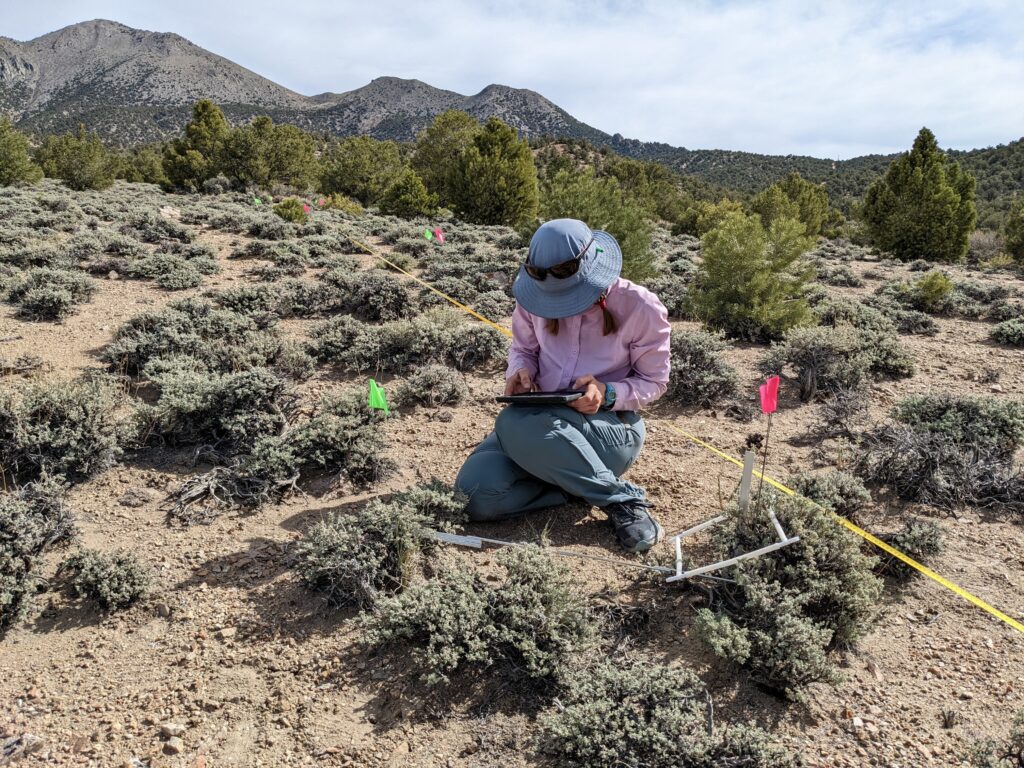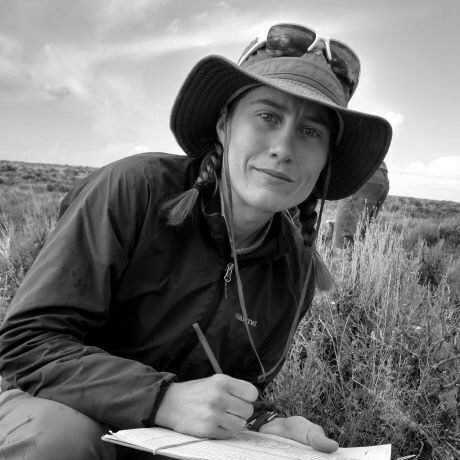As a kid growing up in Florida, we were warned that the hottest part of the day was between noon and 2 pm. My mother insisted that we come inside during these hours to avoid the heat and what she considered to be the riskiest time for sunburns. Yet, at 4:30 pm today in this remote corner of southwest Idaho, I am sitting in the meager shade of my truck, still waiting for the heat to break—which should be sometime between 5 and 6 pm. The thermometer in the truck read 96 degrees before I parked, but a steadily gusting wind is keeping me comfortable in the shade. A small collection of cotton ball-clouds are stretched from west to east across the sky to the north, but unlikely to bring any moisture today.
The short-statured grasses and other herbaceous plants around me are dry and brown—by mid-summer, they have set seeds and lie dead (annuals) or dormant (perennials) to weather the seasonal summer drought. Their pallid hue colors the landscape before me—a modest canyon of basaltic bluffs, folding into one another with each bend in the seasonal creek below. Yet, the palette before me is not uniform—on the western slope, big sagebrush (Artemisia tridentata Nutt.)—almost blue against the grasses—interjects texture and a bold statement of life to the scorched scene. Unlike the grasses, big sagebrush will not flower and set seed until late summer. Instead, this deep-rooted shrub evades the summer dry period by drawing upon water stored deep in the soil, beyond the reach of grasses.
At the center of my view is an abrupt cut of green from the willows and grasses along the creek. Although the creek is dry, sub-surface moisture accumulated from the surrounding landscape will sustain this lush vegetation until fall. On the eastern slope of the canyon, a sea of senescent grasses is punctuated by tumbled boulders from the basaltic ledge above. There is no sagebrush on this side. The dry grasses on this slope reveal a telltale blush. This is cheatgrass (Bromus tectorum L.), a non-native annual grass that has become wildly successful at colonizing these landscapes. The lack of big sagebrush tells me a fire has burned1, and the dense growth of cheatgrass tells me that there won’t be any big sagebrush here for a while. Fire kills this shrub and cheatgrass is associated with increased fire risk—meaning that any sagebrush seeds that blow in and sprout will likely be burned before they are able to re-establish a mature stand. There is cheatgrass among the sagebrush on the western slope, too—the eastern slope presents it with its likely future. And fire is not unlikely here; a large thunderstorm passed west and south of us yesterday and we watched a plume of smoke rise and streak across the sunset. By this morning there were only occasional puffs of smoke—perhaps this one will stay small2.
The challenge of cheatgrass and wildfire in big sagebrush ecosystems is one of the most critical issues facing the region. As I travel across the West this summer, my thoughts often turn to cheatgrass—it would be hard not to think of it: as it starkly delineates wildfire boundaries, as I pull its sharp seeds out of my shoes and socks, as I carefully find a place to park my truck where the hot undercarriage will not set fire to the dry seed heads. Yet, cheatgrass is not my focus this summer. Instead, my research is set upon the puzzle laid out to the west—the dried perennial grasses and the vibrant sagebrush. The two strategies for survival in this dry place achieve the same thing: drought avoidance. The grasses speed through their growing season before the summer drought takes hold, while big sagebrush looks to deeper soils where the drought is not so severe. Yet, shallower soils hold the bulk of the nutrients and sagebrush has a large crop of roots in these layers—an investment it wouldn’t make if it weren’t accessing water here. So, sagebrush must compete with grasses early-season for soil moisture where their roots coincide. And here I’m talking about perennial grasses; the ones that persist for years and, somehow, establish a kind of coexistence with big sagebrush.
In parts of Nevada, summer precipitation is inadequate to support grasses and many of my sites—like this one—were dominated by big sagebrush.
In some places—like south-central Nevada—perennial grasses are sparse, suggesting that there is inadequate water in shallow soil layers to support these plants. Big sagebrush thrives here, drawing upon more reliable deep soil water resources. In these places in particular, the difference between shade and sun is stark. Perhaps here, where perennial grasses are rare, big sagebrush canopies offer shelter—in the form of shade—from the harsh conditions. At night, big sagebrush roots passively redistribute water from wet to dry parts of the soil—potentially providing a sub-surface water source to grasses after the shallow soil layers have dried. In these locations, big sagebrush may facilitate grasses so that the plants are larger or more numerous under shrubs than in open areas.
In central Montana, spring and early-summer precipitation provide ample water in shallow soil layers and grasses are abundant.
Elsewhere, such as Wyoming and Montana, spring and early summer precipitation—which contribute substantially shallow soil water resources—is plentiful and perennial grasses are abundant. Perhaps here, where conditions are favorable to grasses, big sagebrush canopies provide little advantage over open areas and instead of providing shelter, proximity to shrubs represents locations where competition for water is most pronounced.

Measuring the size and number of grasses and other non-woody plants at a site in west-central Nevada.
Photo credit: Phoebe Ferguson.
This summer, I am traveling across the West to visit relatively undisturbed big sagebrush sites with average precipitation ranging from less than 7 to nearly 25 inches per year. I began this project last summer, visiting sites in Wyoming, Colorado, Utah, and Idaho. This year, I am adding sites in Montana, Wyoming, Idaho, Nevada, Utah, Oregon, and Washington. At each site, I count and measure the grasses and other non-woody plants growing under and between shrubs. If plants tend to be larger or more numerous under shrubs than in open areas, I will infer that their relationship with big sagebrush is facultative, and if the opposite is true, I will infer that the relationship is competitive. This research will provide insight into how shrub-grass interactions might be modified by where and when water is available in the soil. Understanding what conditions result in positive (facultative) or negative (competitive) interactions will inform potential pathways to achieve management goals in different parts of the big sagebrush region.
Six o’clock. The sun has dipped low enough that the heat is no longer building around me, and the air can begin to cool (though slowly). In the morning, I’ll walk up the hill away from the creek to a spot that I mapped as high-quality big sagebrush habitat last spring. Despite the apparent lack of water, this is a wet site, receiving almost 20 inches of precipitation each year. The measurements I make here will add another piece to the puzzle I’m working on, building a picture of how the interactions between grasses and big sagebrush vary along gradients of soil moisture amount and seasonality. But for now, I’ll take advantage of the sun’s retreat and take myself for a walk across this remote and wild patch of high desert.
1 The National Interagency Fire Center Historic Wildfire Perimeter database records this as the Cat fire, which burned approximately 42 square miles here in 2018.
2 The Idaho Department of Lands Fire Map indicates that this fire (named the “Annie Fire”) covered about 122 acres and was contained by July 13, 2022.

Rachel Renne, Western Resource Fellow | Rachel grew up in rural southwest Florida, in the heart of orange and cattle-country. After graduating from New College of Florida in 2008, she began a three-mile-per-hour tour—on foot—of the subtle and dramatic shifts of vegetation across the American landscape, hiking over 11,000 miles on National Scenic (and other) Trails. Rachel completed a Masters of Environmental Science at the Yale School of Forestry and Environmental Studies in 2018 and is now a doctoral student at the Yale School of the Environment. She is fascinated by how soils translate climate into vegetation in drylands, and her favorite drylands are big sagebrush ecosystems. She is interested in combining traditional field data with artificial intelligence to answer fundamental and applied questions about plant community ecology. See what Rachel has been up to. | Blog
